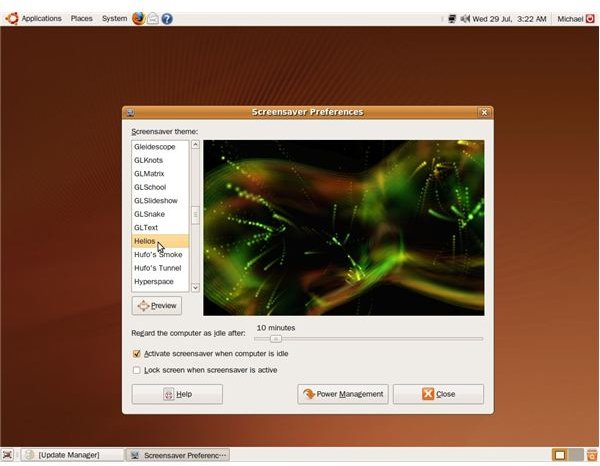

- #Ubuntu xscreensaver sssd how to#
- #Ubuntu xscreensaver sssd install#
- #Ubuntu xscreensaver sssd download#
Logout or reboot for all changes to take effect. If you want to manually lock the screen with the keyboard combination CTRL+ ALT+ L then you will need to run the following to repoint the old gnome-screensaver lock to xscreensaver sudo ln -s /usr/bin/xscreensaver-command /usr/bin/gnome-screensaver-command Or possibly: Open ' System Settings ' and select ' Screen Locking '.
#Ubuntu xscreensaver sssd how to#
Open the ' Control Center ' and select the ' Appearance & Themes / Screensaver ' page. on Kindle How to Use a Kindle Paperwhite How to Make a Book Cover Your Kindle Screensaver How to Turn Off Popular Highlights on Kindle How to Change the. Now to start the xscreensaver daemon on login you need to search in Dash for startup applicationsĬreate a new entry running the command xscreensaver -nosplash To replace the KDE screen saver with XScreenSaver, do the following: 1: Turn off KDE's screen saver. Now start the xscreensaver configuration tool - from a terminal: xscreensaver-demoĬlick OK to both prompts asking to turn-off Gnome Daemon and to start xscreensaver-daemon respectively. Now remove gnome-screensaver sudo apt-get remove gnome-screensaver
#Ubuntu xscreensaver sssd install#
Potential workaround - installing xscreensaver sudo apt-get install xscreensaver xscreensaver-gl-extra xscreensaver-data-extra Open the ' Control Center ' and select the ' Appearance & Themes / Screensaver ' page. However, at the time of writing, no implementation has been started. I have not been able to find any default Ubuntu screensaver in Ubuntu 22, and I was wondering if there were any plans of adding screensavers to the desktop OS While the third party Xscreensavers work, it would be nice to have some default selections. To replace the KDE screen saver with xscreensaver, do the following: 1: Turn off KDEs screen saver. second factor) on GDM login and screensaver unlock screen - Resolves.
#Ubuntu xscreensaver sssd download#
This is different from Network User Authentication with SSSD, where we integrate the AD users and groups into the local Ubuntu system as if they were local. Download sssd-kcm-2.5. for CentOS 8 Stream from CentOS BaseOS. But first, set the domain name on the client machine. For the client to be able to use LDAP for users and groups, and Kerberos for authentication, you need to configure SSD. A Samba server needs to join the Active Directory (AD) domain before it can serve files and printers to Active Directory users. Step 3 Install and Configure SSSD on Ubuntu. The Canonical Devs thought it was a useful idea to continue and raised a blue-print for implementation in Oneiric.Ī few ideas were raised such as a Compiz specific implementation or reusing a Lubuntu/Xubuntu screensaver implementation. Member server in an Active Directory domain. The replacement screensaver is just a blank screen. Once installed, select hot corner actions via extension setting either by Extensions utility or Gnome Tweaks tool.The Gnome 3 Devs dumped the old gnome-screensaver. Heres the default unedited nf in Ubuntu 20.10: sssd -version 2.3.1 cat /etc/sssd/nf sssd domains webtool.

ago How to disable sleep and configure lid power settings for Ubuntu or Red Hat. SSSD-connected domain user does not share the same UID/GID on Ubuntu as AD. Turning off the screensaver also turns off the sleep mode, Im guessing. I installed gdm3 in an attempt to change both over to a single interface, but all it did is replace sddm leaving xscreensaver as my login after idle. NOTE: Skip the first 2 steps if you’re not first time installing a Gnome Shell extension.ġ.) Open terminal by pressing Ctrl+Alt+T on keyboard, then run command: sudo apt install chrome-gnome-shellĢ.) Go to, and click the link to install the browser integration.ģ.) Click the link to go to custom hot corner extension page, then toggle on and click install the extension. I have an AD environment with IDMU and specified UID/GID for my domain users. Upon logging in on Lubuntu 19.04 it is using sddm, but when the computer is idle too long and it goes into idle, when I go to log back in it is using xscreensaver(which I cant stand the look of). You can however set up more actions for the 4 corners via a Gnome Shell extension. The default Gnome desktop only supports top-left corner opening Activities overview, though it’s not enabled by default. With hot corners enabled, when you move the mouse cursor and hit one of the screen corners, it performs a predefined action (e.g., show desktop, open application launcher, launch a software, and run custom command).

This simple tutorial shows how to enable and set up hot corners features in Ubuntu 20.04 with the default Gnome desktop.


 0 kommentar(er)
0 kommentar(er)
